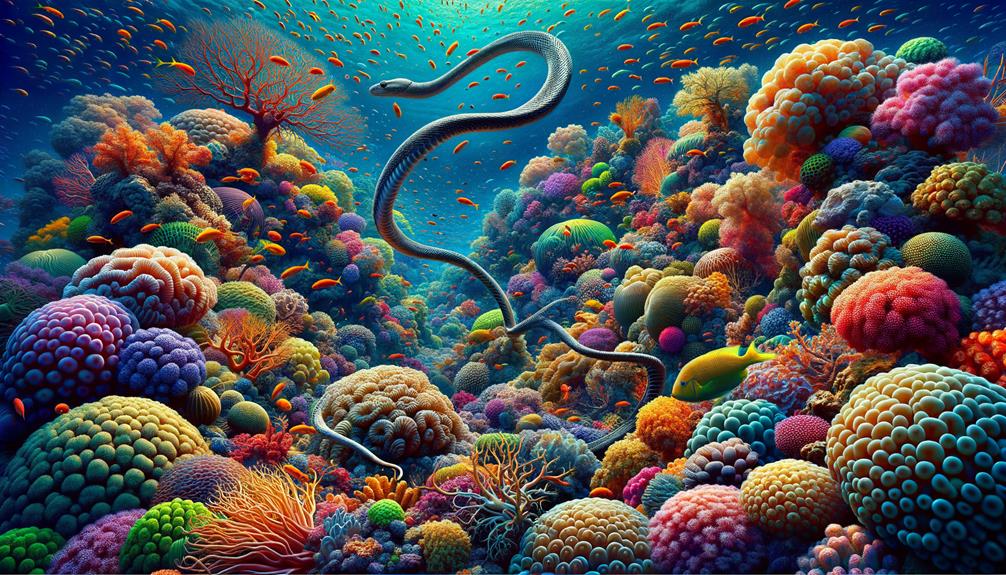I recently spotted a gharial lounging on a Ganges sandbar, its long snout glistening in the sunlight. These remarkable reptiles flourish in the pristine waterways of India and Nepal, particularly favoring deep spots near river bends for sunbathing and cooling off. With their needle-like teeth, gharials are skilled fish catchers, playing a key role in balancing river ecosystems by controlling fish numbers. However, their future is at risk due to habitat loss, illegal hunting, and water contamination. What steps are currently underway to ensure these ancient creatures continue to thrive in the Ganges River system?
Habitat and Distribution
Gharials thrive in the clear freshwater rivers of the Ganges and its offshoots in India and Nepal. They prefer the deeper waters found at river bends, where they can soak up the sun or cool off in the shade. These impressive creatures make their homes near sand banks, which serve as crucial spots for basking and nesting. The rivers' currents shape these deeper areas, creating ideal hideaways for gharials.
Sadly, their habitat has shrunk dramatically. By 1976, their global range had dwindled to just 2% of its former size. Local populations have disappeared in Pakistan, Bhutan, and Myanmar, underscoring how fragile their existence has become. Today, conservation work focuses on the remaining 1,100km of river where gharials still live. Protecting these areas is crucial for the survival of this ancient species.
The sand banks and deep waters of these river bends aren't just geographical features; they're essential to the gharials' survival. By keeping these habitats clean and undisturbed, we're not only helping gharials but also maintaining the delicate balance of the entire river ecosystem.
Physical Characteristics
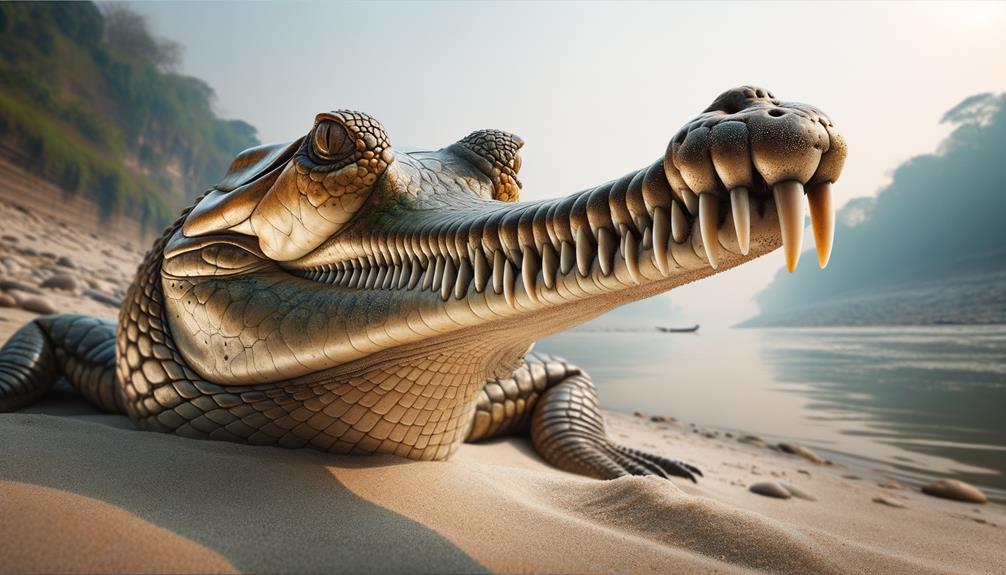
Gharials catch the eye with their striking snouts – long, slender, and packed with razor-sharp teeth that interlock perfectly. These fish-catching specialists stand out among crocodilians, not just for their distinctive muzzles, but also for their impressive size. Their unique physical features aren't merely for show; they're crucial tools for survival in the Ganges River ecosystem. The gharial's body design is a testament to nature's ingenuity, perfectly adapted to its aquatic hunting lifestyle. These reptiles offer a fascinating glimpse into how form follows function in the natural world, with every aspect of their anatomy fine-tuned for life in their riverine habitat.
Long, Narrow Snouts
Gharials stand out among river creatures with their distinctive long, thin snouts. This unique feature is perfectly suited for their fish-based diet. Their streamlined jaws cut through water effortlessly, allowing them to catch prey with minimal splashing.
Male gharials sport an extra feature – a bulbous growth on their snout tip called a ghara. This isn't just for show; it amplifies their hissing calls during mating season, helping them attract females.
A quick comparison highlights some key gharial traits:
| Feature | Gharials |
|---|---|
| Snout Shape | Long, narrow |
| Primary Diet | Fish |
| Male Distinction | Ghara for calls |
| Habitat | Ganges River |
| Population Decline | 98% since 1940s |
These specialized snouts showcase how nature fine-tunes species for their environments. The gharial's adaptations underscore the importance of protecting their habitat to maintain biodiversity.
Their unique features offer a window into nature's complexity. As gharial numbers dwindle, conserving their river homes becomes increasingly crucial. These ancient creatures, with their remarkable snouts, remind us of the intricate balance in ecosystems and why preserving them matters.
Distinctive Teeth Arrangement
The gharial's unique tooth arrangement is often overlooked, yet it's key to their hunting success in the Ganges River's fast-moving waters. When their jaws are shut, only the fourth tooth on each side of the lower jaw is visible, showcasing a remarkable evolutionary trait. This setup allows them to snag slippery fish without self-injury, a vital skill for a predator in such a challenging aquatic environment.
These reptiles have teeth perfectly suited for their fish-based diet. Sharp and interlocking, their teeth form an effective trap for any unsuspecting prey swimming nearby. Once caught, a fish has little chance of escape, firmly secured by the gharial's precise bite. This efficiency is crucial in the Ganges, where food competition is fierce and the ability to catch elusive prey can determine survival.
The gharial's tooth arrangement is a prime example of nature's adaptability, perfectly suiting this creature to its specific ecological niche. It's a testament to the intricate ways animals evolve to thrive in their environments, demonstrating the complex interplay between form and function in the natural world.
Immense Body Length
The gharial's remarkable size is hard to miss, with these impressive reptiles often reaching lengths over 16 feet. This isn't just for show – their size is crucial for life in the Ganges River. Their sleek shape, paired with a long, narrow snout, makes them experts at catching fish, their main food source.
Let's break down some key physical traits of the gharial:
| Feature | Description |
|---|---|
| Body Length | Typically surpasses 16 feet |
| Weight | Largest recorded male: 977 kg (2,154 lb) |
| Snout | Males have a unique ghara on snout |
Their size isn't just about swimming – it also helps with body temperature control and showing who's boss. The ghara, a bulb-like growth on male snouts, boosts their mating calls, making it a key feature for reproduction.
Getting to know these physical characteristics helps us grasp the gharial's role in nature. Their unique body shape sets them apart from other crocodiles, making them a fascinating subject for researchers and nature enthusiasts alike.
Diet and Feeding Habits
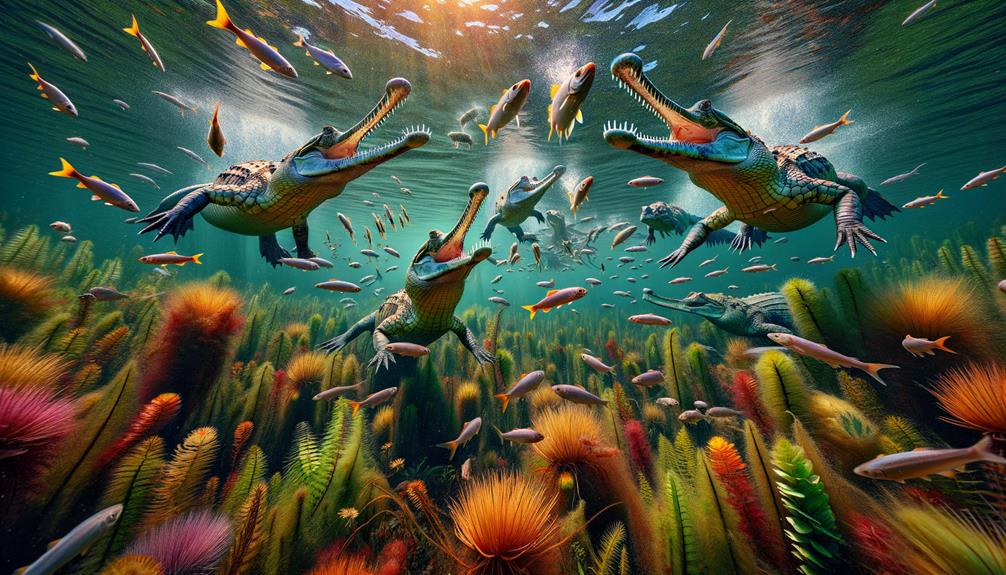
Gharials stand out in the Ganges River with their long, skinny snouts. These unique crocodiles have adapted to be top-notch fish hunters. Fish make up most of their diet, making them key players in the river's food chain. Their special snout shape lets them slice through water and snag fish with impressive skill. This talent is crucial for their survival, as it helps them take advantage of the river's plentiful fish supplies.
The way gharials eat affects the whole Ganges ecosystem. By chowing down on fish, they keep things in check. Here's what you need to know about their eating habits:
- Snout Specialists: Their long, narrow snouts are perfect for grabbing fish, which means they don't compete much with other crocodile species.
- Peaceful Eaters: Unlike their snappier cousins, gharials stick to fish and don't bother other animals in the river.
- Nature's Balancers: By keeping fish numbers in check, gharials make sure no single species takes over, helping maintain the river's rich mix of life.
Thanks to their fish-only diet and laid-back approach to eating, gharials not only survive but also play a big part in keeping the Ganges River's ecosystem healthy and balanced.
Reproduction and Lifespan
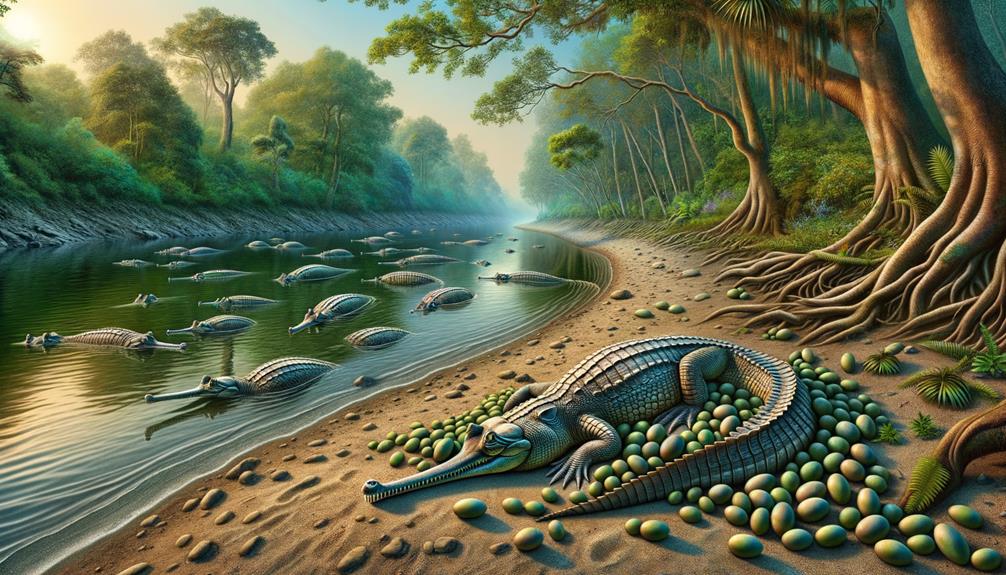
Gharials have a fascinating approach to reproduction. During the dry season, females lay between 20 and 95 eggs in carefully selected sandy spots along riverbanks. These locations offer ideal conditions for the 60 to 80-day incubation period, protecting the eggs from floods and predators.
Mothers show remarkable dedication, guarding the nest at night to ward off threats. This behavior underscores their strong parental instincts. As hatching time nears, both parents often help uncover the nest, ensuring their offspring can emerge safely.
Male and female gharials look noticeably different. Males sport distinctive bulbous growths on their snouts, called gharas, which play a role in mating rituals. Fully grown males can reach impressive lengths of up to 6 meters.
These unique reptiles make their home in the Ganges river system, where their survival and breeding success depend on how well they adapt to their environment. Studying their reproduction and lifespan provides valuable insights into the complex ecosystem these river dwellers inhabit.
Threats to Gharials

The Ganges River's gharials face mounting challenges. Sand mining and riverbed farming are tearing apart their homes, leaving these unique crocodilians struggling to survive. Poachers continue to target them for their skin, meat, and distinctive nose bumps, pushing their numbers dangerously low. On top of that, the water they call home is becoming increasingly toxic. Commercial fishing operations and other industrial activities dump harmful pollutants into the river, creating a poisonous soup that threatens these already vulnerable creatures. It's a perfect storm of human-made problems, putting immense pressure on the gharial population. Without swift action, these ancient reptiles might vanish from the Ganges, taking with them a vital piece of the river's ecosystem.
Habitat Destruction Impact
The Ganges River ecosystem faces a serious threat as gharials struggle to survive amidst widespread habitat loss. Human activities, particularly sand mining and riverbed farming, are the main culprits. These practices wear away nesting areas and upset the river's fragile balance, leaving gharials with fewer spots to lay eggs and rear their young. Sand mining is especially harmful, making riverbeds unstable and unfit for nesting.
The situation worsens with dams and irrigation projects that dry up parts of the river gharials depend on. These reptiles can't simply walk to new areas when their homes are changed or destroyed, making them highly vulnerable. As water levels drop, especially during breeding season in dry months, competition for river space heats up.
Three key points highlight the impact of habitat loss:
- Sand mining destabilizes riverbeds, ruining nesting grounds.
- Dams and irrigation projects dry up rivers, wiping out crucial gharial habitats.
- Limited space during dry periods increases conflicts between local communities and gharials.
Grasping these issues is vital for anyone who wants to help this unique species thrive in its natural home.
Poaching and Illegal Trade
Gharials in the Ganges River face a serious threat from poachers who hunt them for their skin, meat, and distinctive nose bumps. This illegal activity has played a big role in reducing gharial numbers, as hunters target these unique reptiles for various commercial reasons. The promise of quick cash drives poaching, putting gharials at serious risk in their natural homes.
The Ganges ecosystem is complex, and removing a key player like the gharial throws things off balance. Poaching isn't just harmful to wildlife; it damages the whole river system. Gharials, with their long snouts and fish-heavy diet, help keep fish populations in check. As gharial numbers drop, it can cause a ripple effect throughout the river.
Fighting poaching and illegal trade is crucial for protecting gharials. Without tough enforcement and local community involvement, these impressive creatures could disappear forever. It's vital that we back policies and actions that stop illegal trade and safeguard gharials, ensuring they remain a key part of the Ganges River's rich ecosystem.
Pollution and Contamination
The Ganges River faces serious pollution issues, creating a toxic environment that threatens gharials and their ecosystem. The river's contamination stems from various sources, posing multiple dangers to these ancient reptiles.
Industrial activities and commercial fishing dump harmful substances into the Ganges, making it increasingly hostile to wildlife. Let's break down some of the main threats:
Industrial discharges often contain heavy metals like mercury and lead. These toxins build up in the water and fish, which gharials eat, leading to severe health problems.
Agricultural runoff introduces pesticides into the river, further polluting the water. These chemicals harm not just gharials but also their prey, disrupting the entire food chain.
The river is also clogged with plastic waste. Gharials might accidentally eat plastic, which can block their digestive systems and potentially kill them.
Gharials are especially at risk because they depend on the river's fish, which are often contaminated. Tackling pollution in the Ganges is crucial. Organizing clean-up efforts and enforcing stricter rules on industrial discharges could significantly improve water quality, giving gharials a better chance at survival.
Conservation Efforts
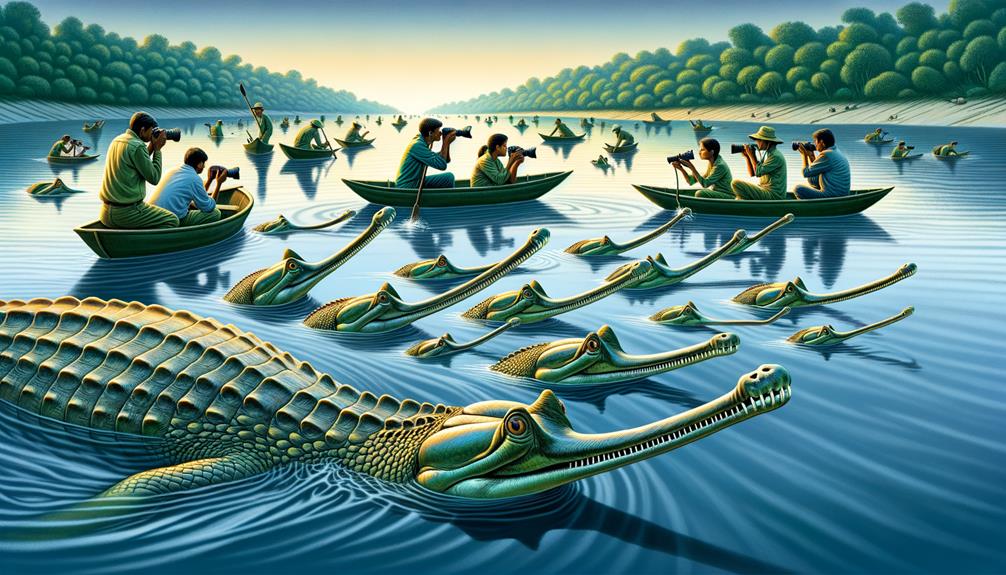
Gharial conservation in the Ganges River has made significant strides, with over 6,000 captive-bred individuals released into their natural habitat. This collaborative effort between India and Nepal has been crucial in preventing the species from dying out. Since the 1970s, when India began offering full protection to gharials, conservationists have implemented breeding and release programs to bolster wild populations.
Despite these accomplishments, the work isn't without its hurdles. A major obstacle is the lack of robust monitoring systems. Without accurate tracking and data collection, it's challenging to gauge the true impact of these initiatives on gharial numbers. This gap in information can hinder the ability to fine-tune and improve conservation strategies based on real-world results.
Nonetheless, ongoing protection efforts remain critical. They aim to halt the decline of this endangered species and ensure its survival for years to come. The dedication shown by these programs highlights a strong commitment to preserving the ecological heritage of the Ganges River system.
The future of gharial conservation depends on addressing these challenges head-on. Improved monitoring techniques, coupled with sustained breeding and release efforts, could significantly boost the chances of long-term success. As conservationists continue their work, they're not just saving a species – they're safeguarding a vital part of the river's ecosystem.
Frequently Asked Questions
Are Gharials Friendly to Humans?
Gharials aren't exactly buddies with humans, but they're not out to get us either. These fish-loving crocs tend to mind their own business, focusing on their aquatic prey rather than people. You're unlikely to run into trouble with a gharial unless you go out of your way to bother one. They're more about keeping to themselves than making friends or enemies. Ecologists often see gharials as good indicators of a river's health, so their presence is generally a positive sign for the environment.
How Many Gharials Are Left in India?
Try picturing a starry sky through a thick blanket of clouds. That's similar to grasping the reality that only about 200 adult gharials remain in India. Their population has shrunk dramatically, making conservation work more pressing than ever. The situation highlights the urgent need for action to protect these unique creatures and their habitats. Wildlife experts are racing against time to implement breeding programs and habitat restoration efforts. The gharial's plight serves as a stark reminder of the broader challenges facing biodiversity in the region.
What Countries Do Gharials Live In?
Gharials call India and Nepal home. These unusual reptiles prefer freshwater rivers, where conservationists are working hard to protect and boost their numbers. As a species on the brink, gharials play a key role in maintaining the health of river ecosystems across both countries.
Efforts to save these ancient-looking creatures have ramped up in recent years. Scientists and wildlife experts are joining forces to create safe spaces for gharials to thrive. By focusing on their natural habitats, researchers hope to see a comeback for these unique animals that have roamed the rivers for millions of years.
The gharial's distinctive long, thin snout makes it stand out among other crocodilians. This feature is perfectly adapted for catching fish, their main food source. By preserving gharial populations, conservationists are also protecting the delicate balance of river life in parts of the Indian subcontinent.
Why Are Gharials Going Extinct?
Gharials face a grim future due to human-caused environmental damage. Their homes are disappearing, food sources are becoming scarce, and young gharials often end up caught in fishing nets. The looming extinction of these creatures serves as a stark reminder of our failure to protect the natural world.


